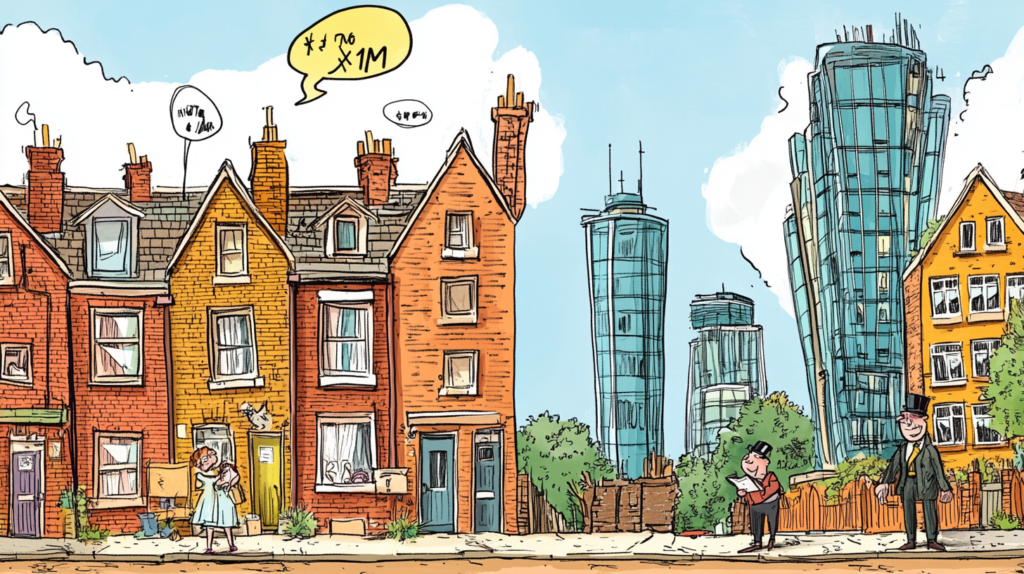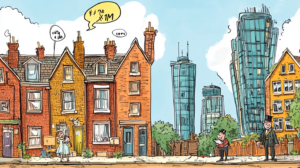In the early 1970s, the UK housing market was a place of contrasts. Amid turbulent economic conditions and soaring inflation, homeownership was within reach for many. Around one‑third of homes were social housing, provided by local authorities to offer affordable alternatives. Back then, an average home cost about £4,000—a modest sum compared to later decades. Even though inflation was running wild and interest rates reached double digits, homes could typically be bought for three to four times the average annual salary. It was a time when modest dreams of owning a house were possible, even if the price tags in nominal terms were on a steady upward climb.
As the country entered the 1980s, the story began to change dramatically. Monetary tightening under Thatcher pushed interest rates to record levels—17% in 1979 was not unheard of—while financial liberalization, symbolized by the “Big Bang” of 1986, opened the floodgates of credit. The government introduced Right to Buy in 1980, giving council tenants the chance to purchase their homes at significant discounts. Over the following decades, more than 1.8 million council homes were sold, and homeownership soared from 55% to nearly 70% by the late 1980s. Yet, as credit flowed more freely, house prices exploded by 164% over the decade, vastly outpacing income growth. By the end of the 1980s, with interest rates settling around 14–15%, the market began to show signs of strain—a harbinger of what was to come.

The early 1990s brought a sharp downturn. After the peak of 1989, average house prices fell by 15–20% in the first half of the decade, leaving many homeowners grappling with negative equity. Interest rates spiked; the Bank of England’s base rate was set at 15% on Black Wednesday in 1992 before gradually retreating. Yet, this difficult period temporarily improved affordability, with the house price-to-income ratio holding steady at around 4:1. By 1995, prices had bottomed out roughly 17% below their late‑80s highs, and as the economy stabilized with low inflation and moderate interest rates of 6–8%, a slow but steady recovery began. The mid‑1990s marked a turning point, with house prices starting to climb faster than incomes. Homeownership expanded further, setting the stage for a property boom in the years ahead.
The late 1990s and early 2000s ushered in an era of unprecedented growth. Abundant mortgage credit, robust economic expansion, and lax lending standards—think interest‑only deals and high loan‑to‑value mortgages—propelled house prices to new heights. Between 1997 and 2007, average house prices nearly tripled in nominal terms. First‑time buyers found themselves squeezed as the price‑to‑earnings ratio rose from around 4:1 in the 1990s to approximately 6.4 in the 2000s, with London and the South East bearing the brunt as ratios in those regions even approached 7–8 times annual income. The era saw property investment gain tremendous popularity, with the buy‑to‑let market booming. At its peak in 2007, the UK housing market was at its highest, only to be rocked by the global financial crisis of 2008. Prices dropped about 15% nationally from 2007 to 2009, and the Bank of England responded by slashing rates to a historic 0.5% in 2009, cushioning the market from a sharper decline.
The 2010s told a story of recovery and transformation. Following the financial crisis, mortgage rates plunged to as low as 0.1%, creating a fertile environment for renewed price growth. The government introduced Help to Buy in 2013, a scheme designed to assist first‑time buyers by providing equity loans that allowed them to secure a property with only a 5% deposit. Help to Buy played a major role in boosting homeownership and stimulating new‑build supply, helping over 350,000 buyers by 2021. Yet even as the policy succeeded, tighter lending standards introduced by the Mortgage Market Review in 2014 meant that while house prices recovered and eventually surpassed pre‑2008 levels, wage growth lagged behind. By the late 2010s, the median house price‑to‑income ratio had climbed to around 7:1, and homeownership rates declined from approximately 70% to 64%. Younger generations faced a dramatic shift, with only 38% of 25–34‑year‑olds owning a home by 2019—a stark contrast to 67% in 1991. The private rented sector expanded as well, doubling its share of households over 20 years as many found themselves priced out of homeownership.
The early 2020s were defined by extremes. The COVID‑19 pandemic initially froze the housing market, but a burst of government stimulus, record‑low interest rates, and a temporary stamp duty holiday unleashed another price boom. In 2022, the average house price reached a record £281,000. However, by 2023 the national home price‑to‑earnings ratio had risen to around 8:1. Then came a cost‑of‑living crisis: inflation spiked above 10%—the highest in 40 years—and the Bank of England pushed rates above 5%. Mortgage payments soared, and many households found themselves paying significantly more each month. Despite a slight cooling in average prices by early 2024, affordability remains stretched thin. Today’s young buyers face a reality where saving for a deposit can take up to 20 years—a far cry from the three years it might have taken in the late 1990s.
Government policies have been central to this odyssey. Right to Buy transformed council housing into private assets, boosting ownership but depleting affordable social stock. Mortgage deregulation in the 1980s and early 2000s fueled dramatic price rises, while the tighter rules of the mid‑2010s forced buyers to come up with larger deposits. Help to Buy provided a short‑term boost for first‑time buyers but also contributed to higher new‑build prices. Meanwhile, the abolition of rent controls in 1988 led to an ever‑expanding private rental market, where rents in places like London now can exceed 45% of a typical pre‑tax salary.
Regional disparities add another twist to the tale. London stands apart with a median house price of about £530,000 and a price‑to‑income ratio of 13.8, meaning an average home costs nearly 14 times the annual salary. In contrast, regions such as North East England, Wales, and Scotland maintain lower ratios—often between 5 and 7—making them relatively more affordable. These local imbalances have driven internal migration and deepened economic divides, with some areas becoming the new frontier for those priced out of the capital.
International comparisons further enrich the narrative. In the United States, while high‑cost cities like New York and San Francisco face similar affordability issues, the average house price per square meter is about 40% lower than in the UK. German housing, with its lower homeownership rates, robust rental protections, and steady supply, stands in stark contrast to the UK’s volatile market. Meanwhile, Australia’s major cities, with price‑to‑income ratios nearing 10, mirror the UK’s struggle with high prices and limited supply.
In conclusion, the UK housing market’s 50‑year journey—from the days of affordable council flats to the era of sky‑high prices—tells a story of relentless change driven by economic forces, policy shifts, and market dynamics. The odyssey is filled with dramatic booms and busts, policy interventions that have both helped and hindered, and stark regional disparities that continue to define the cost of living for millions. Perhaps the greatest irony is that while the market has provided a stellar long‑term investment for some, it has also rendered the dream of homeownership increasingly elusive for the next generation. In the end, the story of UK housing is as complex as it is compelling—one that continues to evolve, leaving us with a wry reminder that in property, as in life, the only constant is change.



